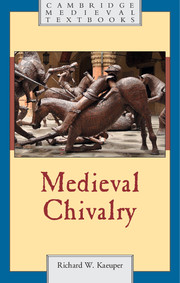Book contents
- Frontmatter
- Dedication
- Contents
- List of figures
- Acknowledgments
- Part I An approach to chivalry: was it real and practical?
- Part II Three broad chronological phases
- Part III The privileged practice of violence
- Part IV Chivalry, governing institutions, and ideals
- Part V The world of chivalric emotions
- Reflections
- Select Bibliography
- Index
Part III - The privileged practice of violence
Published online by Cambridge University Press: 05 August 2016
- Frontmatter
- Dedication
- Contents
- List of figures
- Acknowledgments
- Part I An approach to chivalry: was it real and practical?
- Part II Three broad chronological phases
- Part III The privileged practice of violence
- Part IV Chivalry, governing institutions, and ideals
- Part V The world of chivalric emotions
- Reflections
- Select Bibliography
- Index
Summary
Steeped as we are in images of heroes as knights in shining armor, it is easy to lose sight of the essential function of the elaborate armor and even more elaborate sharp-edged and spiked weaponry that adorn the walls of museums with a wing devoted to the Middle Ages. In one of my own classes designed to make this stark function clear, one student suddenly exclaimed, “I get it! All that weaponry was not merely accessorizing!” Indeed, these armaments were not simply a statement of high fashion, though they undoubtedly fulfilled that function as well. How well such weaponry effected its purpose on the human body, even on the armored human body, could be patiently explained by archaeologists who have investigated military burials. Moreover, the museums will present no remnant of that other great tool of war, the torch, which proved so effective even where the sword could not reach. The two chapters of this part investigate knightly violence, first in actual warfare and then as a form of extreme sport that was a close relative of war. To set the stage for this investigation, we need to focus on chivalric attitudes about the use of violence, including any sense of restraint on its usefulness.
Over centuries, most discussions of chivalry tirelessly projected an ideal image of the elite lay male as a vigorous warrior, proud of his capacity to achieve his twin chief goals of honor and material gain through expert, personal violence. Seldom unqualified, the view shows complexities, for the sources will suggest a great variety of reform plans and ideal models for building a better knighthood (with greater or lesser degrees of subtlety). Even a cycle of chansons de geste or romance texts may carry reform significance through its structure, within and between texts justifying war or warning about excesses. In individual works, these warnings may come with a roll of thunder or may speak only in a stage whisper. The mother of the eponymous antihero in Raoul de Cambrai, for example, gives her son stern admonitions against despoiling the poor or looting or burning churches; his stubborn insistence that he will commit these very acts in his determined fighting – clear violations of the mesure or wise restraint much praised in this and other literary works – leads to her potent cursing of her son.
- Type
- Chapter
- Information
- Medieval Chivalry , pp. 155 - 160Publisher: Cambridge University PressPrint publication year: 2016



